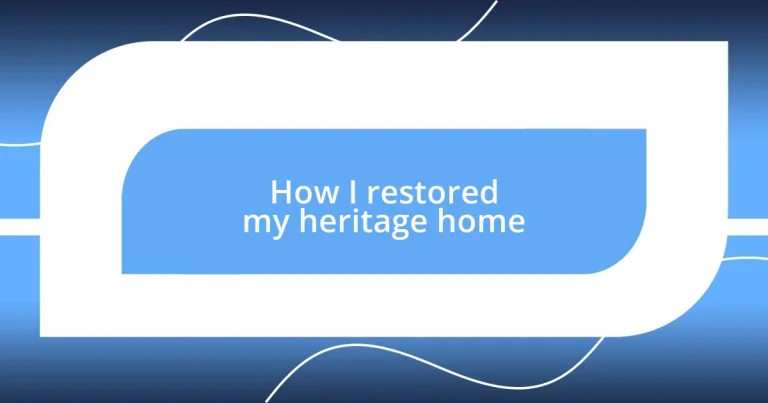Key takeaways:
- Heritage homes are vital cultural artifacts, connecting us with the past and embodying the identity of neighborhoods.
- Creating a thorough restoration plan involves assessing needs, researching historical accuracy, and engaging with professionals.
- Collaborating with skilled craftspeople enhances the restoration process, ensuring authenticity and valuing traditional techniques.

Understanding Heritage Home Significance
Heritage homes hold a unique place in our collective history, serving as tangible reminders of the architectural styles and cultural influences that shaped our communities. When I first walked into my heritage home, I felt an overwhelming sense of connection to the past. How many stories had these walls witnessed? Each creak of the floorboards seemed to echo with laughter and tears from generations before.
The significance of these homes goes beyond aesthetics; they encapsulate the identity of a neighborhood. I often find myself pondering how many families have sat around the same dining table, sharing meals and dreams. It’s this sense of continuity that struck me most while restoring my own home, as I aimed to respect the stories embedded in its very structure.
Preserving heritage homes also fosters a deeper appreciation for craftsmanship that is often lost in modern construction. As I admired the intricate woodwork and original features during the restoration, I felt a profound respect for the artisans who poured their passion into these details. Is there anything more beautiful than a home that tells a story through its design?

Creating a Restoration Plan
Creating a restoration plan is essential for ensuring that every aspect of your heritage home is carefully preserved. When I began this journey, I sat down with a sketchpad and let my thoughts flow freely, jotting down everything that came to mind about the home’s needs and the aspects that meant the most to me. This brainstorming session ultimately helped shape a clear path forward.
To create a solid restoration plan, consider the following steps:
- Conduct a thorough assessment: Identify areas in need of repair and recognize original features worth preserving.
- Research historical accuracy: Learn about the architectural style and materials used in your home to inform your choices.
- Prioritize projects: Determine which aspects must be addressed immediately versus those that can wait.
- Set a realistic budget: Understand your financial limits and allocate funds accordingly for each phase of the project.
- Engage professionals: Consult with experts who specialize in heritage restoration, as their insights can be invaluable.
I remember distinctly spending hours piecing together my plan, feeling overwhelmed yet excited by the vision of what my home could once again become. Each decision was like a step back in time, and I couldn’t help but feel the weight of responsibility to honor its legacy while making it my own.

Selecting the Right Restoration Materials
Selecting the right materials for restoration can truly make or break the authenticity of your heritage home. I vividly recall walking through the local salvage yard, surrounded by pieces that held stories of their own. It was a fascinating treasure hunt! Choosing reclaimed wood versus new materials was a decision I took seriously; the patina of reclaimed wood told a story that new lumber simply couldn’t replicate. I felt like a steward of history, carefully selecting elements that would honor the past while ensuring longevity for the future.
It’s also essential to consider the environmental impact of your choices. For instance, I opted for lime-based plaster rather than modern synthetic alternatives. This decision wasn’t just about aesthetics; lime plaster breathes, allowing the home to manage moisture naturally. As I worked, I found comfort in knowing that my restoration was not only preserving history but also leading to a more sustainable way of living. The idea that each restored crack and crevice breathed new life felt rewarding.
When sourcing materials, I suggest building relationships with local craftsmen and suppliers. I discovered that these connections opened doors to custom solutions tailored for my home’s specific needs. For example, my local mason helped me recreate a historically accurate brick pattern for the chimney, something I couldn’t have achieved through online shopping. Each choice in materials became a dialogue with the past, shaping the home’s character while reminding me of the shared heritage we all carry.
| Material Type | Benefits |
|---|---|
| Reclaimed Wood | Authentic, unique character, reduces waste |
| Lime-Based Plaster | Naturally breathable, eco-friendly, historically accurate |
| Local Craftsmanship | Tailored solutions, preserves traditional skills, fosters community |

Working with Skilled Craftspeople
Working with skilled craftspeople was one of the most rewarding aspects of my restoration journey. I vividly remember the first meeting with my carpenter, who not only measured and assessed the space but also shared stories about similar restorations he had completed. His passion was infectious! I felt an immediate connection to his craftsmanship, which helped to ease my worries about preserving the home’s original character. It was a true collaboration, and I learned to value his insights just as much as my own.
Many people underestimate the value of skilled artisans in heritage restoration. I personally experienced this when my plasterer introduced me to the ancient techniques of hand-troweling. It wasn’t just about making the walls look good; it was about breathing new life into them with tradition and skill. Watching him work felt like witnessing art in motion, and it made me appreciate the depth of knowledge these craftsmen bring. Have you ever seen someone truly master their craft? I found it humbling, reminding me that my home was not just a project, but a canvas for someone else’s expertise.
When selecting craftspeople, I realized the importance of a shared vision. I recall my electrician, who thoughtfully checked every historical detail before making recommendations. His respect for the building’s integrity resonated with me. Each conversation reinforced my commitment to authenticity—together, we were not just fixing a house; we were honoring history. If you’re embarking on a similar journey, I encourage you to listen to the stories these skilled hands have to tell. Their work, combined with your vision, can create a unique narrative that echoes the spirit of your heritage home.

Finalizing the Restoration Process
As I approached the final stages of the restoration process, I couldn’t help but feel a mix of excitement and nostalgia. Final touch-ups, like repainting the window frames, were a delicate balance of preserving the home’s authenticity while introducing a fresh vibrancy. I remember meticulously choosing a color that echoed its original hue; standing back and admiring the transformation was deeply satisfying. Have you ever experienced the thrill of seeing your hard work come together? I certainly did, and it was a moment I’ll forever cherish.
Finalizing the details also meant embracing the quirks that made my heritage home truly unique. For example, instead of replacing an old door with a standard model, I sought to repair the original one, complete with its charming imperfections. Each scratch and dent told a story of ages past, and I felt compelled to honor that narrative. At times, it felt like listening to the house itself, as if it was whispering its own secrets; can you imagine the past lives within those walls?
In those final moments, I realized the importance of reflection. Walking through the newly restored spaces, I took time to appreciate the craftsmanship, the materials, and my journey as a whole. There’s something poetic about restoration—it’s not purely physical; it’s emotional too. I often found myself daydreaming about future gatherings and memories that would unfold within this lovingly revived space. How do you envision a home woven with stories? For me, those stories are now part of every corner of my heritage home, and that connection is priceless.














